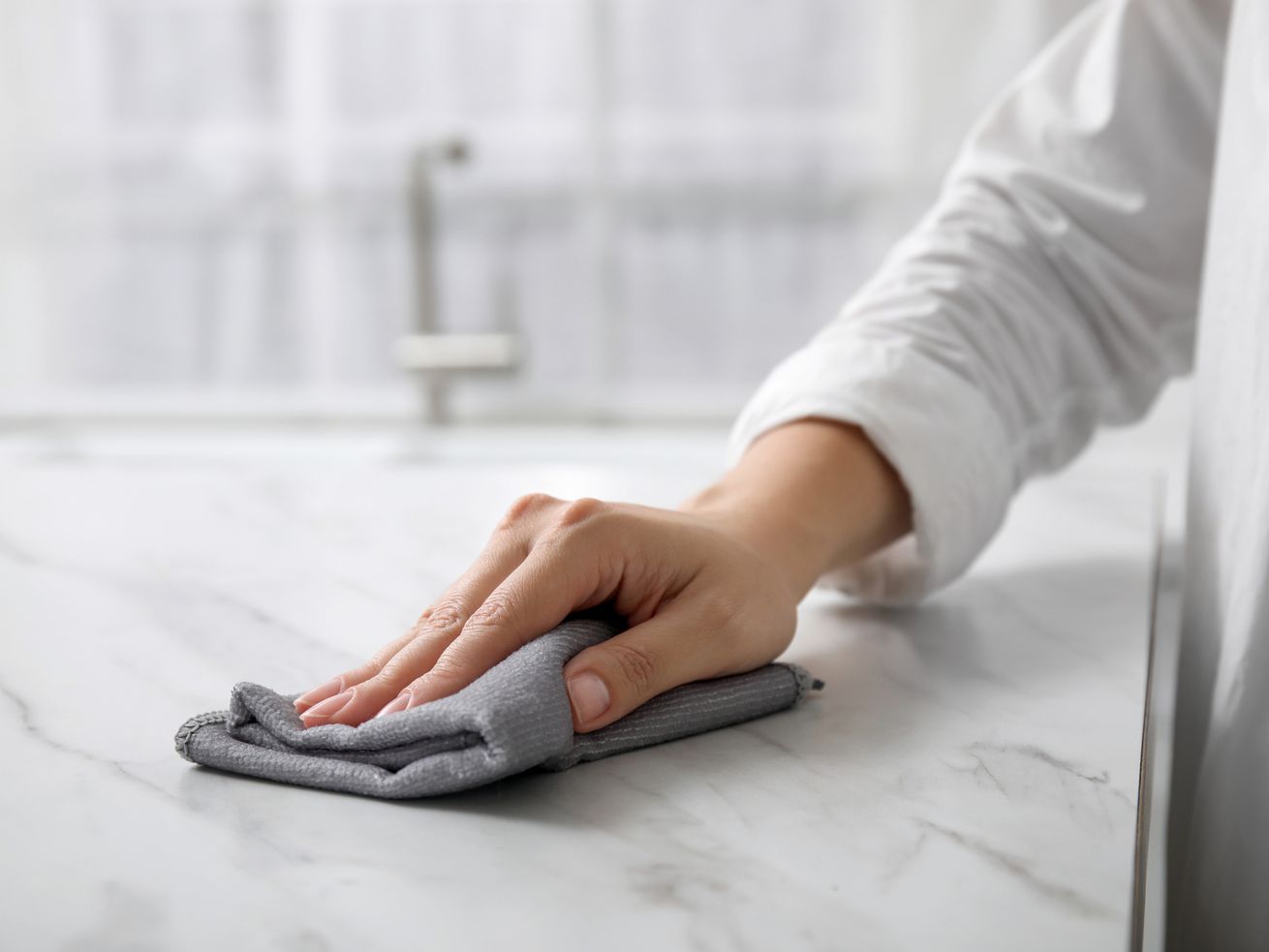
Getty Images
TikTok is full of millennial gray, competitive hygiene, and bleach. It stinks!
In November, a woman put her prepackaged Christmas tree in the tub and washed it. “Unpopular opinion: You need to clean your Christmas tree,” she wrote on the TikTok video devoted to documenting the experience, during which viewers can see perfectly clear water circling the drain, as if it wasn’t obvious enough that nobody actually needs to hose down a chunk of plastic that comes straight from a cardboard box. She was right about one thing: It was indeed an unpopular opinion; the comments on the video, which went viral on both TikTok and X, ranged from annoyed (“sometimes I think people clean just to make other people feel dirty”) to mocking (“me doing anything at work to make it look like I’m busy”) to diagnosing her with obsessive-compulsive disorder.
The people, it seems, have had enough of this kind of thing: missives that fake plants must be washed before being displayed, that every week you need to do a “Sunday reset” in which every inch of your home is scrubbed to squeaky perfection, that even items used to clean other items need their own aesthetically pleasing plastic containers, that it’s normal to have nearly a dozen 85-count Clorox wipes on hand at all times, that one should treat their collection of Scrub Daddies and Pink Stuff spray bottles like precious collector’s items, that “if you’re not showering after the bar, what are you doing?,” that “clean girl” is an aspirational aesthetic rather than one that is heavily rooted in racist and classist messaging about who gets to look and feel “pure.”
On TikTok and elsewhere on the internet, people are pushing back against what they call “performative cleaning” or the “hygiene Olympics.” K.C. Davis, the counselor and author of the book How to Keep House While Drowning, devotes her TikTok account to empathetic approaches to housekeeping, warning people against conflating cleanliness with morality. Performative cleaning is “when we clean or keep house in order to become someone, to become that woman who has it together and feels so peaceful and so happy, instead of recognizing that who I am right now is worthy or caring for,” she explains in one video.
Women are posting videos of their “realistic” homes and hashtagging them #hotmessmom or #nonaestheticmom, as a response to the dominant domestic ideal that fetishizes sterility and colorlessness. “What if you just didn’t clean that up?” asked The Cut last year, noting how expectations of cleanliness are stuck in the 1950s: racist, sexist, classist, and useful only when one person in every household can devote their lives exclusively to the labor of cleaning. When Julia Fox gave a TikTok tour of her apartment, people praised her for how “normal” and lived-in it was. Even Marie Kondo, she of the “life-changing magic of tidying up,” said she’s “kind of given up” on keeping a perfectly clean home.
@kaelimaee
welcome to stock-up-saturday havent done a restock in awhile! #asmr #asmrsounds #restock #restocks #restockasmr #organizedhome #organize #clean #cleantok
♬ original sound – kaeli mae
Was it ever really about hygiene? Did the Christmas tree lady, for instance, truly believe that her unwashed plastic Christmas tree could make her sick? One would assume not. The vast majority of TikToks where a person takes you through their cleaning regimen go viral because they are either visually satisfying (the New York Times called them “narcotic pleasures”) or because the poster knows her cleaning practices are excessive enough that people will feel lacking in comparison and give it a hate-watch (or, ideally, a hate-share). One redditor satirized this genre of post, writing “Y’all wash your body with the same hands that you used to wash it with yesterday instead of chopping em off and growing a clean new pair? LMAOOO EW.”
Whether excessive attempts at germ riddance are even successful is debatable: Disinfectants also end up killing the “good,” non-disease-causing germs that help people digest food and build immunity, and can cause long-term risks like antibiotic resistance or exposure to harmful fumes. According to the “hygiene hypothesis,” oversanitized households can be a possible reason that allergies, asthma, IBS, and other autoimmune disorders have skyrocketed in wealthy, developed nations in recent decades.
But the American obsession with cleaning has never been about facts. It’s about feelings. What began as patriotic duty during the Civil War has curdled into a never-ending stream of unnecessary products advertised to us by weaponizing our insecurities. The pandemic only exacerbated the germaphobia baked into American culture: The Atlantic’s Derek Thompson coined the term “hygiene theater” to describe the ways in which people and businesses have prioritized less effective measures of preventing the spread of Covid, such as obsessively disinfecting surfaces or putting hand sanitizer at every table, at the expense of more effective ones, like proper ventilation, mask-wearing, and social distancing. “People are power scrubbing their way to a false sense of security,” he wrote. What makes us feel cleaner, in other words, doesn’t actually make us so.
@its.michele.ok
Make you feel like the dirtiest person ever . #pov #hygiene #cleanfreak #micheleok
♬ original sound – Michele
One could view obsessive cleanliness as natural responses to, as the saying goes, “unprecedented times”: Furiously cleaning one’s home soothes an itch caused by living in a dirtier, more dangerous world. The thing is, we don’t. People are healthier and live longer than ever before in human history. Crime in America has plummeted in recent decades, even though people tend to believe the opposite. The economy is, overall, pretty good. Yet Americans remain stubbornly convinced that doom is just over the horizon. It is true that getting sick in the US is scarier than it would be in a country with a more civilized social safety net and a less draconian health care system, but the mostly harmless germs in our homes probably aren’t going to be the reason we’re left with a massive medical bill.
Watching someone scrub their marble countertops is as much an aesthetic impulse as it is a psychological one, though. Current architectural and interior design trends favor spaces that are open, airy, and white — so, so white, and if not white, then gray. From McMansions to apartment complexes, interiors have been “greigified” into soulless, easily replicable units thanks to a combination of venture capital-backed real estate investments, career house flippers (and the TV shows that lionize them), and penny-pinching landlords who use cheap laminate flooring that’s since earned its own nickname: “millennial gray.” The result is spaces that only look nice when they are spotless. Where a maximalist approach to decor might camouflage a stain or a speck of dirt, a minimalist, hyper-clean home emphasizes it. It’s no wonder that the majority of people on #cleantok, the segment of TikTok devoted to videos of scrubbing and organizing, seem to live in homes devoid of much personality beyond a curated collection of Stanley tumblers, $600 hair dryers, or the latest viral skin care tool or diet food (Collagen powder? Blended microgreens? Sure!).
We weren’t always surrounded by depictions of uber-clean gray homes, just as we weren’t always overwhelmed by images of faces and bodies “perfected” by injectables and plastic surgery. In her essay “Everyone Is Beautiful and No One Is Horny,” Raquel S. Benedict juxtaposes the aspirational, affluent home of 1980s cinema with the contemporary ideal:
There are toys and magazines scattered around the floor. There are cardboard boxes waiting to be unpacked since the recent move. Framed pictures rest against the wall; the parents haven’t gotten around to mounting them yet. The kitchen counters are cluttered and mealtimes are rambunctious and sloppy, as one expects in a house with three children. They’re building a pool in the backyard, but not for appearances: it’s a place for the kids to swim, for the parents to throw parties, and for the father to reacquaint himself with his love of diving.
It is a home where life happens, not a home where the evidence of life must be diligently erased. “Compare this to homes in films now: massive, sterile cavernous spaces with minimalist furniture,” she writes. “Kitchens are industrial-sized and spotless, and they contain no food. There is no excess. There is no mess.” This, she argues, is due to a shift in the way American culture has viewed both the body and the home: as assets whose value must appreciate at all costs.
It’s all the likely result of doing the majority of our socializing via a screen, where the image of something becomes more important than what it actually is, or does, or how it makes us feel. We were never meant to tour this many people’s sterile gray homes, or look at this many people’s waxed, deodorized bodies, or know exactly how many bottles of Shout someone buys at Target to keep it all sparkling. Doing so has warped our perception of what and whom cleanliness is for, and vastly overestimated how much any of it matters. Cleaning is already tedious enough — why make it even more so?
This column was first published in the Vox Culture newsletter. Sign up here so you don’t miss the next one, plus get newsletter exclusives.
——————————————-
By: Rebecca Jennings
Title: There’s something icky about performative cleanliness
Sourced From: www.vox.com/culture/24031823/cleantok-cleanliness-tiktok-performative-hygiene
Published Date: Wed, 10 Jan 2024 14:00:00 +0000
Read More
Did you miss our previous article…
https://politicscope.com/social-issues/thousands-of-ai-experts-are-torn-about-what-theyve-created-new-study-finds/
I'm a writer for lifestyle publications, and when I'm not crafting stories, you'll find me cherishing moments with my family, including my lovely daughter. My heart also belongs to my pets—Sushi, Snowy, Belle, and Pepper. Besides writing, I enjoy watching movies and exploring new places through travel.

